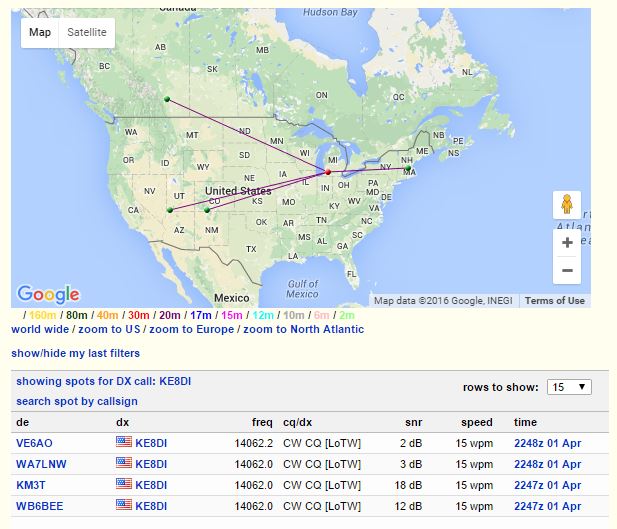
Electrician's Knot
This is an inexpensive lightweight easy to build antenna option that would be a great choice for temporary, portable or stealth operation. The antenna was featured in QST (March 1979 and March 2009) as well as the ARRL Antenna Book – page 19-2 of the 23rd edition.
Basically, the antenna is a half-wave-center-fed dipole. The construction material is zip line – two conductor cord commonly used for AC power plugs and lamp wiring. I purchased a 250 foot spool at a local big box home improvement store for less than $50. That amounts to a little less than 20-cents per foot. A real bargain when we consider this is for the antenna AND feedline.
There are a couple formulas that we will need to construct this antenna. The first zip cord antenna I built was for 20 meter CW so I will use that as an example. The first formula is to calculate 1/4 wave for one half of the dipole. This is the standard 234/f MHz So 234 / 14.06 (QRP CW Calling Frequency) came out to 16 feet, 7-5/8 inches. I rounded this up to 17 feet to give me room to trim for resonance as well as fold back a few inches at the end to create a loop which will be used to attach rope for hanging the dipole later.
The second formula is used to determine the electrical wave length of 1/2 wave for the feedline portion. In this case 492 / f MHz X VF. VF is the velocity factor. This can be determined through either measurement using an antenna analyzer or through calculation. I used a VF of 70% as this number was referenced in several places including the QST articles, the ARRL Antenna book and several online resources. I thought I would use it as a starting point and upon initial testing it seemed to be right on. So, 492 / 14.060 X 0.7 = 24.5 feet. So to start with I cut one length of zip cord to 17+24.5 = 41.5 feet. At 20 cents a foot we have now invested $8.30 – not bad!
From one end of the cord we measure down the 17 feet that will be the antenna portion. We separate these two conductors down to this point. The zip cord pulls apart easily once you get it started. I used a knife to cut the first inch or so and then just pulled with my hands down to the 17 foot point. At this point I tied an “electricians knot” which will help keep the zip cord from continuing to separate beyond this point.

Electrician's Knot
The rest of the wire is the feedline. As a quick theory reminder here, the impedance of the feedline does not matter. Sources indicate that the impedance of this zip cord feedline is between 100 and 150 ohms. You could measure it if you wished. However, remember it doesn’t matter. Why does it not matter? An electrical half wave (or multiple) of ANY feedline will repeat the impedance of the load The dipoles impedance is theoretically 72 ohms but will vary based on height, surroundings and angle of the legs. The impedance of the dipole will be repeated at the end of this half-wave feedline and should be a close enough match to have an SWR of 1.5:1 or better at the design frequency. This is going to be a single band antenna, however I found a better than 2:1 SWR across the entire 20-Meter Band.
A quick test in the backyard with the antenna at about 25 feet and the SWR was good, about 1.2:1 at 14.060 MHz. I called CQ a few times at 5watts and got the following RBN Spots:

Reverse Beacon Network Spots from first CQs on the 20 meter antenna.
This is a compromise antenna (aren’t all antennas a compromise though?). What you get is an inexpensive, lightweight, and easy to build and put up antenna. The main compromise is going to be loss in the feedline. The feedline loss is going to be greater than RG-58 coax. Also being an unshielded feedline it is going to be best to suspend the feedline away from other objects especially metal objects.
If a longer feedline is needed, there are two options. The impedance of the antenna will repeat on each multiple of half wavelength so you can add 24.5 feet lengths of zip cord to get to where you need to go. Adding more feedline will add more loss. So, the other option is to connect a 50-ohm coax to the end of the zip cord feedline and connect to the rig. With this option there is more weight to carry, but lower loss. The choice will depend on your specific situation and needs.